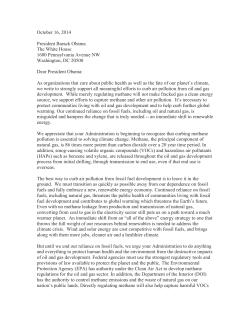
NATURAL GAS—FUELING THE BLUE FLAME
Fossil Energy Study Guide: Natural Gas NATURAL GAS—FUELING THE BLUE FLAME Natural Gas: It is colorless, shapeless, and in its pure form, odorless. For many years, it was discarded as worthless. Even today, some countries (although not the United States) still get rid of it by burning it in giant flares, so large they can be seen from the Space Shuttle. Yet, it is one of the most valuable fuels we have. Natural gas is made up mainly of a chemical called methane: a Methane simple compound that has a carbon atom surrounded by four (CH4) hydrogen atoms. Methane is highly flammable and burns almost completely. There is no ash and very little air pollution. Natural gas provides nearly one-quarter of all the energy used in the United States. It is especially important in homes, where it supplies nearly half of all the energy used for cooking, heating, and for fueling other types of home appliances. Because natural gas has no odor, gas companies add a chemical to it that smells a little like rotten eggs. The odor makes it easy to smell if there is a gas leak in your house. THE HISTORY OF NATURAL GAS The ancient “eternal fires” in the area of present day Iraq that were reported in Plutarch’s writings around 100 to 125 A.D. probably were from natural gas escaping from cracks in the ground and ignited by lightning. 1 In 1821 in Fredonia, New York, William A. Hart drilled a 27 foot deep well in an effort to get a larger flow of gas from a surface seepage of natural gas. This was the first well intentionally drilled to obtain natural gas. For most of the 1800s, natural gas was used almost exclusively as a fuel for lamps. Because there were no pipelines to bring gas into individual homes, most of the gas went to light city streets. After the 1890s, however, many cities began converting their street lamps to electricity. Gas producers began looking for new markets for their product. In 1885, Robert Bunsen invented a burner that mixed air with natural gas. The “Bunsen burner” showed how gas could be used to provide heat for cooking and warming buildings. It took the construction of pipelines to bring natural gas to new markets. Although one of the first lengthy pipelines was built in 1891—it was 120 miles long and carried gas from fields in central Indiana to Chicago—there were very few pipelines built until after World War II in the 1940s. Improvements in metals, welding techniques and pipe making during the War made pipeline construction more economically attractive. After World War II, the nation began building its pipeline network. Throughout the 1950s and 1960s, thousands of miles of pipeline were constructed throughout the United States. Pipelines Today, the U.S. pipeline network, laid end-to-end, would stretch to the moon and back twice. Fossil Energy Study Guide: Natural Gas GETTING GAS FROM THE GROUND...AND THE SEA Natural Gas Formations Natural gas is, in many ways, the ideal fossil fuel. It is clean, easy to transport, and convenient to use. Industrial users use almost half of the gas produced in the United States. A large portion is also used in homes for heating, lighting, and cooking. However, there are limits on how much natural gas we can find and get out of the ground with today’s technologies. These are the areas of the United States and Canada where natural gas formations are found. Researchers are continuing to study about how natural gas was formed and where it has collected within the earth’s crust. They have found that gas is not only found in pockets by itself but in many cases, with oil. Often, both oil and gas flow to the surface from the same underground formation. Like oil production, some natural gas flows freely to wells because the natural pressure of the underground reservoir forces the gas through the reservoir rocks. These types of gas wells require only a “Christmas tree,” or a series of pipes and valves on the surface, to control the flow of gas. Only a small number of these free-flowing gas formations still exist in many U.S. gas fields, however. Almost always, some type of pumping system will be required to extract the gas present in the underground formation. One of the most common is the “horse head” pump (see photo) which rocks up and down to lift a rod in and out of a well bore, bringing gas and oil to the surface. Often, the flow of gas through a reservoir can be improved by creating tiny cracks in the rock, called “fractures,” that serve as open pathways for the gas to flow. In a technique called “hydraulic fracturing,” drillers force high pressure fluids (like water) into a formation to crack the rock. A “propping agent,” like sand or tiny glass beads, is added to the fluid to prop open the fractures when the pressure is decreased. 2 Natural gas can be found in a variety of different underground formations, including: • shale formations, • sandstone beds, and • coal seams. Some of these formations are more difficult and more expensive to produce than others, but they hold the potential for vastly increasing the nation’s available gas supply. They are often referred to as “unconventional” sources of natural gas. Fossil Energy Study Guide: Natural Gas Scientists are exploring ways to use gas from these unconventional sources. Some of the work has been in Devonian shales, which are rock formations of organic rich clay where gas has been trapped. Dating back nearly 350 million years (to the Devonian Period), these black or brownish shales were formed from sediments deposited in the basins of inland seas during the erosion that formed the Appalachian Mountains. Devonian shale actually gave birth to the natural gas industry in this country. The first commercial natural gas well was drilled into a shale formation in New York. It produced only a few thousand cubic feet of gas per day for 35 years, but it heralded a new energy source. Other sources of unconventional gas include “tight gas sands.” These deposits are called “tight” because the holes that hold the gas in the sandstone are very small. It is hard for the gas to flow through these tiny spaces. To get the gas out, drillers must first crack the dense rock structure to create ribbon-thin passageways through which the gas can flow. Coalbed methane gas that is found in all coal deposits was once regarded as only a safety hazard to miners but now, due to research, is viewed as a valuable potential source of gas. Scientists are studying another type of gas, called methane hydrates, found in deep ocean beds or in cold areas of the world, such as the North Slope of Alaska or Siberia in Russia. A methane hydrate is a tiny cage of ice, inside of which are trapped molecules of natural gas. Research is also continuing on a theory that gas pockets that were not formed from decaying matter but were formed during the creation of the Earth may be found deep in the ground. 3 Horse Head Pumping System One of the most common pumping systems. It rocks up and down to lift a rod in and out of a well bore, bringing gas and oil to the surface. Once natural gas is produced from underground rock formations, it is sent by pipelines to storage facilities, then by smaller pipes to homes and factories. So the next time you see the blue flame on top of the kitchen stove, remember that the natural gas that is being burned likely came from an underground rock formation hundreds, if not thousands, of miles away.
© Copyright 2025





















